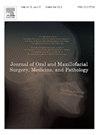Assessment of biomechanical strength of titanium versus unsintered-hydroxyapatite/poly-L-lactic acid (u-HA/PLLA) osteosynthesis screws in bilateral sagittal split ramus osteotomy
IF 0.4
Q4 DENTISTRY, ORAL SURGERY & MEDICINE
Journal of Oral and Maxillofacial Surgery Medicine and Pathology
Pub Date : 2024-10-19
DOI:10.1016/j.ajoms.2024.10.004
引用次数: 0
Abstract
Titanium osteosynthesis is considered to be stable for the bilateral sagittal split ramus osteotomy (BSSRO) procedure in orthognathic surgery but is disregarded owing to a multitude of complications, the most significant necessitating a secondary surgery for removal. Bioresorbable osteofixation devices, especially third-generation unsintered-hydroxyapatite/poly-L-lactic acid (u-HA/PLLA), are increasingly used in the mandibular region because of their strength and bioactive/osteoconductivity. To date, three titanium bicortical screws has been the standard for the rigid fixation of BSSRO. As data on the use of u-HA/PLLA bicortical screws are limited, we conducted an in vitro biomechanical strength test to evaluate the performance of 12-mm bicortical u-HA/PLLA screws in comparison with titanium screws using mandibular bone models. BSSRO was performed on all specimens, followed by fixation with either three titanium screws or three, four, or five u-HA/PLLA screws, and loading was performed using a clinically presumed occlusal force. Displacement forces (measured in newton ‘N′) of 50 N, 130 N, and 220 N were applied. Our results showed that the use of three u-HA/PLLA screws was unstable, that of four u-HA/PLLA screws was comparable, and that of five u-HA/PLLA screws provided stability equal to that of the three titanium bicortical screws. Although further clinical assessment is needed, our study demonstrated that the five u-HA/PLLA bicortical screws are viable alternatives to titanium in BSSRO osteofixation.
求助全文
约1分钟内获得全文
求助全文
来源期刊

Journal of Oral and Maxillofacial Surgery Medicine and Pathology
DENTISTRY, ORAL SURGERY & MEDICINE-
CiteScore
0.80
自引率
0.00%
发文量
129
审稿时长
83 days
 求助内容:
求助内容: 应助结果提醒方式:
应助结果提醒方式:


